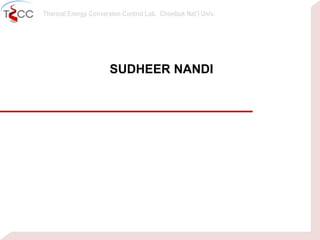Lab seminar
- 1. Thermal Energy Conversion Control Lab. Chonbuk NatâI Univ. SUDHEER NANDI
- 2. Thermal Energy Conversion Control Lab. Chonbuk NatâI Univ. Major Subjected 1. Experimental Technique. 2. Failure Analysis. 3.Advanced Material Technology . 4.Thermal Power plant Engineering. 5.Application Computational Fluid Dynamic 6. Advanced Automobile Technology 7.Sustainable Energy. Master of Technology in Titled Engineering Analysis & Design
- 3. Thermal Energy Conversion Control Lab. Chonbuk NatâI Univ. Experimental Technique. âĒ Experimentation can be defined as -an operation or procedure carried out unde r controlled conditions in order to discover an unknown effect or law, to test or establish a hypothesis, or to illustrate a known law.â
- 4. Thermal Energy Conversion Control Lab. Chonbuk NatâI Univ. Failure Analysis The Word Failure Analysis is methods of forensic Engineering are especially valuable in tracing product d efects and flaws. Most failures can in the end be traced back to a root causes of the type of human errors of any kind. For example, human errors in: Use studies Requirement analysis / setting Configuration control Assumptions Calculations / simulations / FEM analysis/Desig n Design drawings Testing (incorrect load settings or failure measu rement) Statistical analysis &Manufacturing Quality control Maintenance Maintenance manuals Incorrect feedback of information,etc
- 5. Thermal Energy Conversion Control Lab. Chonbuk NatâI Univ. PHYSICAL MECHANICAL ELECTRO- CHEMICAL TECHNOLOGICAL âĒ Extractive âĒ Casting âĒ Metal Forming âĒ Welding âĒ Powder Metallurgy âĒ Machining âĒ Structure âĒ Physical Properties âĒ Deformation Behaviour âĒ Thermodynamics âĒ Chemistry âĒ Corrosion Advanced Material Technology
- 6. Thermal Energy Conversion Control Lab. Chonbuk NatâI Univ. Application Computational Fluid Dynamics CFD âĒ CFD has lagged behind developments in stress analysis codes âĒ Powerful computers now make CFD more accessible âĒ Advantages of CFD over experiments â reduction in lead time and costs of new designs â ability to study systems where controlled experiments are difficult to perform (large systems) â ability to study systems under hazardous conditions at and beyond normal performa nce limits â detail of results
- 7. Thermal Energy Conversion Control Lab. Chonbuk NatâI Univ. 7 Where is CFD used? âĒ Where is CFD used ? âĒ Aerospace âĒ Automotive âĒ Biomedical âĒ Chemical Processi ng âĒ HVAC âĒ Hydraulics âĒ Marine âĒ Oil & Gas âĒ Power Generation âĒ Sports F18 Store Separation Temperature and natural conv ection currents in the eye follo wing laser heating. Aerospace Automotive Biomedical
- 8. Thermal Energy Conversion Control Lab. Chonbuk NatâI Univ. 8 Polymerization reactor vessel - prediction of flow separation and residence time effec ts. Streamlines for workstation ve ntilation âĒ Where is CFD used? âĒ Aerospace âĒ Automotive âĒ Biomedical âĒ Chemical Processi ng âĒ HVAC âĒ Hydraulics âĒ Marine âĒ Oil & Gas âĒ Power Generation âĒ Sports HVAC Chemical Processing Hydraulics Where is CFD used?
- 9. Thermal Energy Conversion Control Lab. Chonbuk NatâI Univ. 9 Thermal Power plant Engineering
- 10. Thermal Energy Conversion Control Lab. Chonbuk NatâI Univ. 10 Thermal Power plant
- 11. Thermal Energy Conversion Control Lab. Chonbuk NatâI Univ. 11 MECHANICAL work In Thermal Plant Boiler. Furnace. Turbine. Super Heater & Re- Heater. PA,FD & ID Fan. Cooling Tower Thermography (system)
- 12. Thermal Energy Conversion Control Lab. Chonbuk NatâI Univ. 12 Advanced Automobile Technology
- 13. Thermal Energy Conversion Control Lab. Chonbuk NatâI Univ. âĒ Virtual and Physical Testing 13 Component testing approach: ï§ Derive loading for demonstrator using âReal Roadâ vehicle test ï§ Set up simulation model for reference module ï§ Find clamping conditions and loading f or reference module ï§ Evaluate simulation models based on r eference tests
- 14. Thermal Energy Conversion Control Lab. Chonbuk NatâI Univ. 14 New Materials Characterization for Failure Prediction Work tasks: ï§Test of shear-tension specimens with v arious joining techniques ï§curves are derived from fatigue tests of s pecimens ï§Create a model to simulate the fatigue b ehaviour of joints based on FE analyses a nd materialâs data ï§Validate the model based on experiment al data (measured strains) ï§Data characterising the crash behaviour are derived from high-speed tensile test ï§Static and dynamic hat profile componen t tests ï§The results of tests will optimize the vir tual simulation model
- 15. Thermal Energy Conversion Control Lab. Chonbuk NatâI Univ. 15 Life Cycle Analysis LCA LCA tasks: ï§Mapping of materials with SLC labels to GaBi processes ï§Integration of a fuzzy logic module to calculate credits for recycling ï§Automated calculation of LCA results ï§Generation of an application executable with c ommand line parameters that offers completely automated LCA result generation from CAD.
- 16. Thermal Energy Conversion Control Lab. Chonbuk NatâI Univ. Sustainable Energy Technologies ï§ Renewable energy technologies ï§ Sustainable habitats ï§ Industrial energy efficiency ï§ Waste management and waste to energy ïŧPhotovoltaics ïŧBiomass and bioenergy ïŧOther areas such as ï·wind ï·geothermal ï·ocean ï·concentrated solar thermal
- 17. Thermal Energy Conversion Control Lab. Chonbuk NatâI Univ. 17 A smart, sustainable energy system Centralised fuel production, power and storage Renewable energy resources EV Co-generation Smart energy system control Distributed energy resources Surplus heat H vehicle2 A sustainable energy system is a smarter, more unified and integrated energy system
- 18. Thermal Energy Conversion Control Lab. Chonbuk NatâI Univ. 18 Thank you for your attention


















